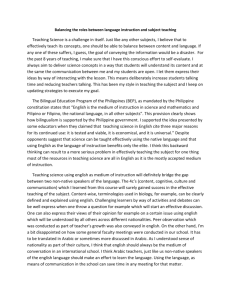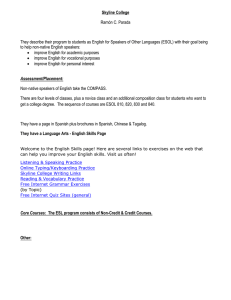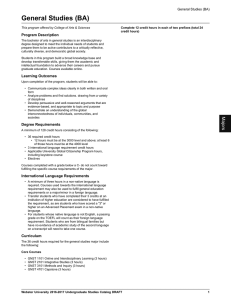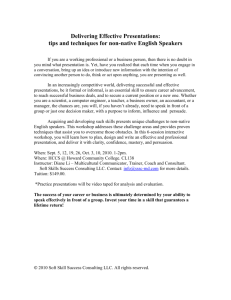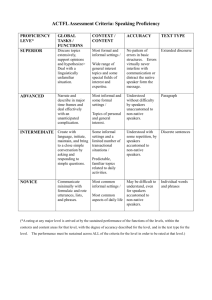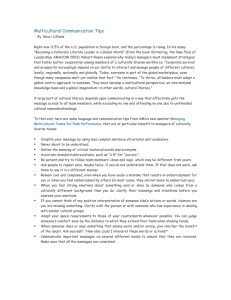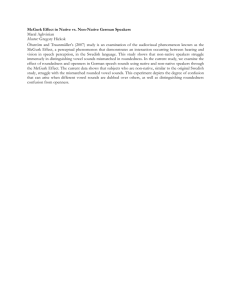May 12, 2009 A SCCD Workshop for Faculty and Staff 5/12/2009
advertisement
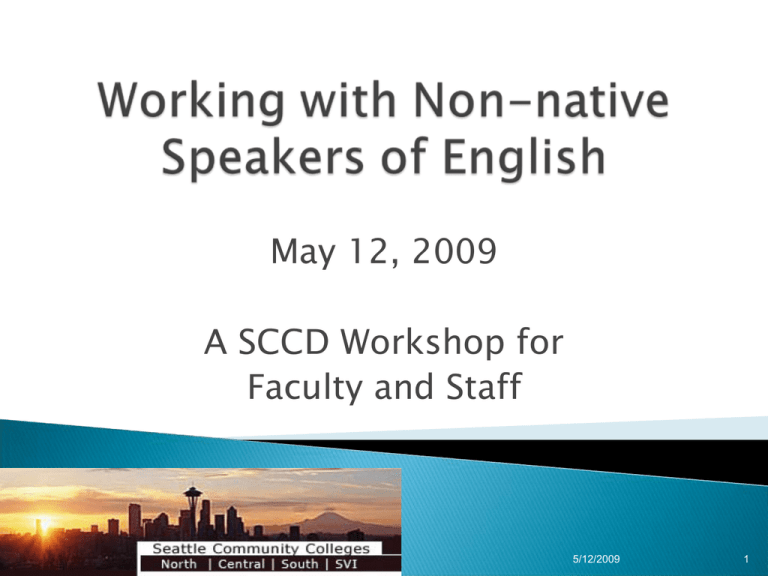
May 12, 2009 A SCCD Workshop for Faculty and Staff 5/12/2009 1 Collaborative Effort by District Faculty Development and Global District Council Patti Conley, Faculty Development Coordinator Andrea Insley, District Coordinator, International Programs 5/12/2009 2 Initiate discussion on this topic Point people to available resources Broaden awareness of our own cultural framework and of how this impacts our interactions Enhance our appreciation of what it is like to be a non-native English speaking student on our campuses. 5/12/2009 3 A website including faculty resources in working with non-native English speaking students has been established through District Faculty Development: http://dept.sccd.ctc.edu/fd/default.aspx?p g=nonnativeenglish Link will also be included in the District International Programs pages http://seattlecolleges.edu/international 5/12/2009 4 Tina Young, Central, Director of Multicultural Initiatives Understanding Cultural Identity Through an Identity Development Lens 5/12/2009 5 Saovra Ear, South, ESL, Transition Services/Advisor Strategies for Working with Non-native Speakers of English (focus refugee/immigrant populations) 5/12/2009 6 Dana Servheen, North, Program Coordinator of International Programs Trang Nguyen, North, International Student from Vietnam Student Services Challenges and Best Practices 5/12/2009 7 Bob Dela-Cruz, South, Instructor Best Practices in the Classroom 5/12/2009 8 Karen Michaelsen, Central, Librarian/Faculty Help non-native English speaking students understand and avoid plagiarism. 5/12/2009 9 By Tina Young Director of Multicultural Initiatives Seattle Central Community College 5/12/2009 10 To introduce concepts for consideration, reflection, and exploration to deepen understanding of cultural identity – one’s own and the identity of others – in order to strengthen practice inside and outside the classroom 5/12/2009 11 ◦ Identity is complex and individual ◦ Identity development is a process ◦ Everyone is at a different point in their understanding of their own identity and the identity of others 5/12/2009 12 History, traditions, values, cultural articulations 5/12/2009 13 •Norms, Rules •Cultural Dimensions •Institutional Dimensions 5/12/2009 14 Social Identity categories describe dimensions of personal identity, i.e., Race Ethnicity Birthplace Age Gender Economic class Physical Ability Sexual Orientation 5/12/2009 15 1. Conformity Stage – “What do you mean I’m different?” 2. Dissonance Stage – “I can’t believe this is happening to me” 3. Resistance and Emersion Stage – “ I’m confused and full of rage!” 4. Introspection Stage – “Oh now I understand, I may be wrong.” 5. Synergistic Articulation and Awareness Stage – “I found my place in the big picture.” Reference: Atknison, D.R., Morten, G., & Sue, D.W. (1998). Counseling American minorities (5th ed.). New York: McGrawHill 5/12/2009 16 5/12/2009 17 By Sy Ear Transition Services Advisor South Seattle Community College 5/12/2009 18 These are the 9 strategies that I use every day in working effectively with non-native speakers in the Advising/Counseling office 1. 2. 3. 4. 5. 6. 7. 8. 9. Communication is more time consuming Be aware of etiquettes in different cultures Speak slowly and clearly Use formal English Restate what students are saying or asking Repeat ideas not understood Ask student to summarize Put communication in writing Remember to be patient! 5/12/2009 19 Have a positive attitude Allow more time Example: If it takes 10 minutes to communicate with a native speaker, plan for 15-30 minutes for a nonnative speaker 5/12/2009 20 Be aware that cultural etiquettes could be different from other countries Non-native speakers are also adjusting to the “American” culture Examples: ◦ Some may not look you in the eyes ◦ Some may not shake or touch your hands (Don’t be offended!) 5/12/2009 21 Remember that most non-native speakers have had limited exposure to English Do not raise your volume with these students; that might be more of a distraction to them They might not be accustomed to regional accents They mostly are not ready for the conversational speed of native speakers 5/12/2009 22 Eliminate use of slang (It is usually only understood by the local culture) Most non-native students exposed to English might have been limited to English teachers and pronunciation tapes, etc. 5/12/2009 23 Sometimes students do not have the vocabulary or command of the English language to get across what they are trying to say or ask It may help clarify what students are trying to say 5/12/2009 24 Don’t assume that non-native students will automatically understand Blank look on student’s face Student asking the same question again and again 5/12/2009 25 Some students nod their head in politeness even though they do not understand Again, be patient with the student; it will take non-native speakers longer to summarize than native speakers 5/12/2009 26 Whenever possible have visual aids Seeing it in writing helps them process the information Also, it helps eliminate misunderstanding 5/12/2009 27 It can be frustrating trying to communicate with a non-native speaker Imagine how frustrated non-native speakers are not being able to find words to ask questions and not understanding native speakers It can be rewarding! 5/12/2009 28 By Dana Servheen Program Coordinator of International Programs North Seattle Community College Trang Nguyen International Student, North Seattle Community College 5/12/2009 29 •ADMISSIONS •HOUSING •INITIAL FACE-TO-FACE CONTACT •DOCUMENTATION •TESTING/PLACEMENT •ACADEMIC PLANNING •FINANCES •RULES AND POLICIES 5/12/2009 30 Parents, agents or extended family members often complete application paperwork and make initial arrangements for students to come to the United States. Some students arrive expecting most details to be taken care of and not aware of the numerous steps required to register for classes. * Be aware of stresses a student may be experiencing * Build relationships with students * Be careful not to assume that students understand 5/12/2009 31 Home stay housing is often chosen by parents or agents. Students find themselves living with families from different cultural, social and religious backgrounds. They experience different habits and customs such as pets living in the house, hectic family schedules, and unusual foods. Often they are responsible for doing their own laundry and cleaning for the first time. Ask about how the student is getting along Encourage them to talk with their host family Suggest other housing options 5/12/2009 32 Building rapport and trust with new students is important. For many, arriving at college in the US is the first time they experience people from diverse cultures. Organized orientation programs are an important way to introduce them to our multicultural society, allowing them to learn about others and to develop a new support system. ☺Provide a warm, personal welcome by introducing yourself ☺Become the student’s first corner stone if building a new support system 5/12/2009 33 Immigration and institutional requirements for documenting and tracking students can be demanding and confusing. Students from different backgrounds react differently to the requirements of sharing personal data. • Acknowledge concerns and safety issues • Explain in detail what is needed • Explain the consequences 5/12/2009 34 Students arrive with high expectations and pressure to succeed. They often want a step-by-step plan that tells them what to do and when to do it in the quickest way possible. Testing and placement can be viewed as an obstacle to be overcome. Explain that their success is important Emphasize that good grades can be more important than going fast Encourage students to become involved 5/12/2009 35 Perhaps for the first time in their lives, international students become responsible for their own finances. Not only do they have to pay all their own bills, but they have to learn how to do this in a foreign culture with new and different systems. Don’t assume students understand payments Provide detailed information Explain the consequences 5/12/2009 36 The US immigration rules and policies for international students are numerous and complicated. Students must comply to both immigration AND institution rules, the consequences for non-compliance can be severe. 5/12/2009 37 By Bob Dela-Cruz Instructor South Seattle Community College 5/12/2009 38 1. Know your non-native English speaking students 2. Research their ethnic/cultural backgrounds 3. Reach out to the students academically 4. Reach out to the students personally 5/12/2009 39 a. b. c. Create and distribute a student data survey Have students introduce themselves Share your background; ask them for theirs 5/12/2009 40 a. b. c. d. Determine academic concerns/problems Learn about their native educational policies and procedures Learn about their history, social customs, and traditions Learn a few words in their native language such as “Hello” or “Thank you” 5/12/2009 41 a. b. c. Create course assignments which include/allow for the use of the students’ backgrounds Provide tailored assistance for the students’ specific concerns Be available during 1) Office hours and 2) Non-office hours 5/12/2009 42 a. b. c. d. e. Greet students in their native language Play native music in class Recognize and talk to the students outside of the classroom and not always about academics Listen to the students and their concerns; when appropriate, provide advice; advocate for the students Attend functions involving the students 5/12/2009 43 Karen Michaelsen Faculty/Librarian Seattle Central Community College ©2009 5/12/2009 44 “Academic Integrity is a fundamental value of teaching, learning, and scholarship. Yet, there is growing evidence that students cheat and plagiarize.“ Center for Academic Integrity: http://www.academicintegrity.org 5/12/2009 45 –noun 1.the unauthorized use or close imitation of the language and thoughts of another author and the representation of them as one's own original work. 2.something used and represented in this manner. "plagiarism." Dictionary.com Unabridged (v 1.1). Random House, Inc. 19 Feb. 2009. <Dictionary.com http://dictionary.reference.com/browse/plagiar ism>. 5/12/2009 46 EVE Plagiarism Detection System (This is a viable option for individual faculty.) Turnitin.com (This is a subscription service for individual faculty or an entire institution.) 5/12/2009 47 Cheating students cheat themselves. We want our students to develop: ◦ Self-responsibility ◦ Critical thinking ◦ Information literacy ◦ Ethical behavior http://www.seattlecentral.org/sccc/outcomes.php 5/12/2009 48 Teach students we expect original work Develop assignments that make it hard to cheat 5/12/2009 49 Student Conduct Incident Report 1. To unit administrator 2. To VP for Student Services Official responses 1. First time – may be a slap on the hand 2. Second time treated more seriously 5/12/2009 50 How can we turn a case of cheating into a learning experience? 5/12/2009 51 Teach students to avoid plagiarism: A tutorial from our neighbors to the north… http://library.acadiau.ca/tutorials/plagiarism/ Communicate expectations ◦ Include language on the course syllabus ◦ Develop a contract which asks students to affirm they will comply 5/12/2009 52 Academic integrity should be a campus value. Work with your colleagues to develop this culture. http://www.academicintegrity.org/ Students who see others cheat and get away with it are more likely to do likewise. 5/12/2009 53 “The information literate student understands many of the economic, legal, and social issues surrounding the use of information and accesses and uses information ethically and legally.” American Library Association 5/12/2009 54 Use the strategies we learned today – Make it hard to cheat; ask students to: Compare two sources Relate something to their own experience Apply a local issue to the global environment (or vice-versa) 5/12/2009 55 Librarians can help with research assignment design and resources Do we have what your students need? Do you know your librarian? NSCC http://dept.sccd.ctc.edu/nslib/faculty.htm#Division SCCC http://dept.sccd.ctc.edu/cclib/For_Faculty/liaisons.asp SSCC http://dept.sccd.ctc.edu/sslib/contactus.asp 5/12/2009 56 Center for Academic Integrity – promote values of academic integrity on campus Stanford University Library – resources on copyright and fair use guidelines Plagiarism.org – research resources for students and teachers 5/12/2009 57 Mary Acob-Nash Sara Baldwin Colleen Comidy Pamela Cox Tram Dang Tom Davis Afke deJong-Keefe Bob DelaCruz Ann Dwyer Saovra Ear Sharon Gilman Greg Hinckley Andrea Insley Linda Johnston Reza Khastou Kathie Kwilinski Tracy Lai Dan Loos Monica Lundberg Christine Nguyen Steve Quig Robert Schuessler Dana Servheen Barbara Silas Brian Smith Seana Sperling Yilin Sun Karen VanGenderen Andrea Vederoff Howard Xie Tina Young 5/12/2009 58 Questions? 5/12/2009 59
